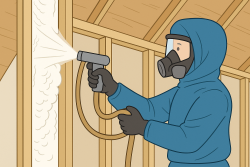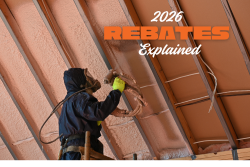Are you a homeowner looking to maximize your property's energy efficiency and comfort? If so, perhaps you are wondering what are the best insulation options. You need an insulation material with high thermal resistance value for the areas of your home causing air leaks. Most heat transfer occurs from the roof; the chances of heat loss are higher, especially if you have flat or cathedral roofs. Read this helpful blog to find the most suitable insulation materials and R-value for your flat roof or cathedral ceilings.
The Challenges in Flat Roof and Cathedral Ceiling Insulation
Cathedral ceilings and flat roofs can pose challenges when it comes to insulation due to limited space and unique structural designs. Cathedral ceilings are characterized by their sloping design, which creates a vaulted or raised ceiling effect. Insulating cathedral ceilings can be challenging because the space between the roof and the ceiling is typically limited. Flat roofs also present challenges when it comes to insulation. In traditional flat roofs, insulation is typically placed on top of the roof deck, under the waterproofing layer. However, this can increase the risk of condensation and moisture issues.
For Cathedral Ceilings and Flat Roofs, Why is an R-value of 31 Recommended?
Cathedral ceilings or flat roofs are commonly known for high heat leakage rates, moisture accumulation and other issues. Due to these unique insulation challenges, it's recommended to use a material with an R-value of 31. Here we have listed why it is important to use an insulation material with an R-value of 31.
Temperature Regulation
Insulating cathedral ceilings and flat roofs with a high R-value helps maintain more consistent indoor temperatures. It reduces the impact of external temperature variations, preventing heat or cold from easily transferring into the living space and providing a more comfortable environment.
Limited Space for Insulation
Cathedral ceilings and flat roofs often have limited space for insulation due to architectural design constraints. To achieve optimal insulation performance, selecting materials with higher R-values that provide more insulation per unit thickness is crucial. This allows for efficient insulation within the limited available space.
Reduced Thermal Bridging
In these areas, there can be a higher likelihood of thermal bridging, which occurs when heat easily transfers through conductive materials, such as metal roof decks or rafters. Insulation with a high R-value minimizes thermal bridging by providing a more effective barrier against heat transfer.
What is The Optimal Insulation Choice for Cathedral Ceilings and Flat Roofs?
There are several insulation options available that can achieve an R-value of 31 or higher, including:
Spray Foam Insulation
Spray foam insulation is sprayed as a liquid that expands to fill cavities and create an airtight seal. Closed-cell spray foam insulation typically has a high R-value and provides excellent thermal performance.
Rigid Foam Insulation
Rigid foam boards made from polystyrene or polyisocyanurate can be installed on cathedral ceilings and flat roofs. These boards offer high R-values and can be layered to achieve the desired insulation level.
Blown-in Fiberglass or Cellulose
Loose-fill insulation, such as blown-in fibreglass or cellulose, can be installed in hard-to-reach areas and effectively cover uneven spaces. These materials can achieve high R-values when installed to the appropriate thickness.
Insulated Panels
Insulated panels, also known as structural insulated panels (SIPs), consist of rigid foam insulation sandwiched between two panels, typically made of oriented strand board (OSB). These panels provide both insulation and structural support.
Contact Reitzel Insulation
Consult a professional insulation contractor or an energy auditor to determine the most suitable insulation option for your needs and location. Let Reitzel Insulation help; with over 46 years of experience, we provide the best insulation solutions. Maximize your home's comfort while minimizing energy bills. Call us now to schedule your insulation project.
.png)

















